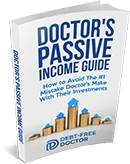How to Become Financially Independent and Retire Early
Ever wondered what it really means to become financially independent? For some, it’s about retiring early and traveling the world. For others, it’s having the freedom to work part-time or focus on a passion project without worrying about bills.
No matter what financial freedom looks like to you, learning how to become financially independent can help you design a life where money supports your goals instead of holding you back.
Rather watch instead? Check out this video:
Don’t Miss Any Updates. Each week I’ll send you advice on how to reach financial independence with passive income from real estate.
Sign up for my newsletterWhat Is Financial Independence?
Financial independence means having enough income from investments, rental properties, or other passive income streams to cover your living expenses without relying on a traditional paycheck. When your monthly income from these sources meets or exceeds your monthly expenses, you have the choice to work because you want to, not because you have to.
This doesn’t happen overnight. It requires planning, discipline, and a shift in mindset from simply earning and spending to building long-term wealth.
Building Your Financial Foundation
Understand Your Income and Expenses
The first step to becoming financially independent is understanding your cash flow. Calculate exactly how much money comes in each month (your after-tax income) and how much goes out.
Review your bank accounts, credit card statements, and even small, everyday purchases. Many people are surprised to see how small expenses like coffee runs or streaming subscriptions add up over time.
Knowing your annual expenses, monthly payments, and how much you spend on living expenses gives you a clear picture of your financial health. This awareness is key to setting realistic goals and tracking progress.
Build an Emergency Fund
An emergency fund is your financial safety net. It covers unexpected expenses like car repairs, medical bills, or a sudden job loss.
Aim to save at least three to six months’ worth of living expenses in a savings account or high-yield savings account. This fund prevents you from falling back on credit card debt when life throws surprises your way.
Pay Off High-Interest Debt
Debt can be one of the biggest roadblocks on the path to financial independence. Focus on paying off high-interest debt first, such as credit card balances and payday loans. Use strategies like the avalanche method (tackling the highest interest rate first) or the snowball method (starting with the smallest balances for quick wins). Reducing debt improves your savings rate and frees up money for investments.
Create a Budget That Fits Your Life
A budget isn’t about restriction — it’s about control of your finances. Think of it as a tool to help align your spending with your financial goals. Budgeting helps you decide where to spend, where to save, and where to cut back without feeling deprived.
Set up automatic payments to your savings account, investment account, or even a special “fun fund” so you can enjoy guilt-free spending on travel or hobbies. Automating your savings makes it easy to build wealth consistently.
Create Multiple Income Streams
The Power of Side Hustles
Relying solely on a single paycheck makes you vulnerable. Developing multiple income streams — like a side hustle — can cushion you against unexpected job loss or economic downturns. Whether it’s freelance writing, graphic design, or consulting, side hustles allow you to leverage your skills and interests for extra cash.
Side hustles also help young adults and professionals pay down student loans, save for early retirement, or build a nest egg faster. Plus, they can evolve into full-time businesses if that aligns with your long-term goals.
Investment Income: Letting Your Money Work for You
Once your finances are in order, it’s time to start investing. Investment income is a cornerstone of financial independence because it allows you to generate money without trading your time directly.
Invest in stocks, mutual funds, real estate, or exchange-traded funds (ETFs). If the idea of picking stocks makes you nervous, consider low-cost index funds or working with a certified financial planner.
Over time, these investments can provide capital gains, dividends, and rental income — all of which contribute to covering your living expenses.
Rental Properties and Real Estate
Real estate investing is a classic and effective way to generate passive income. Owning rental properties can create steady monthly income while your property appreciates in value.
Whether it’s a single-family home, RV park, or even mobile home parks, rental income can become a reliable part of your financial plan.
Working with a property manager allows you to stay hands-off, turning what would be active income into a more passive investment. This is ideal if you don’t want to handle day-to-day operations yourself.
Other Passive Income Ideas
Aside from real estate and investments, there are other ways to create forms of passive income. You might write an online course, sell digital products, or invest in private equity or real estate syndications.
These methods allow you to continue earning even when you’re focused on other things.
Related: Real Estate Syndications: How I Started Investing as a Dentist
Join the Passive Investors CircleMaster Smart Spending and Saving
#1. Mindful Spending
Mindful spending involves aligning your purchases with your values rather than buying on impulse. Ask yourself: “Does this purchase support my goals?” If not, skip it.
Avoid unnecessary spending and prioritize experiences or items that bring you true joy.
#2. Automate Savings
Set up automated savings so you don’t have to think about it. Even small automatic transfers from your checking account to a savings account or investment portfolio can grow significantly over time.
This habit ensures you’re consistently building your wealth.
#3. Avoid Lifestyle Inflation
As your income grows, it’s tempting to upgrade your lifestyle. Avoid lifestyle inflation by maintaining your current spending levels and directing extra income toward savings or investments.
This strategy speeds up the journey to financial independence and prevents future financial stress.
Invest Wisely for Long-Term Growth
Know Your Investment Options
Diversify your investment strategy using a mix of stocks, mutual funds, bonds, and real estate. Each asset class has its own risk level and potential return. A balanced investment portfolio helps protect against market volatility and supports steady growth.
Start Small and Grow
You don’t need a lot of money to start investing. Many investment accounts allow you to start with small amounts. The important thing is to start early so you can take advantage of compound growth over a long time frame.
Use Retirement Accounts
Maximize your contributions to 401(k) plans, IRAs, or similar retirement accounts. Employer matches are essentially free money and can significantly boost your net worth. These accounts also offer tax advantages, which help you grow your money faster.
Rebalance Regularly
Periodically review and rebalance your investments. Life changes — such as career shifts, new family members, or changing financial goals — might require adjustments to your asset allocation. Checking in ensures your portfolio remains aligned with your objectives.
Adopt a Mindset for Financial Success
From Consumer to Investor
Transitioning from a spending-focused mindset to an investing mindset is a crucial step. Focus on building assets that generate income rather than spending on depreciating items. This mindset shift is often what separates those who achieve financial independence from those who stay stuck living paycheck to paycheck.
Embrace Patience
Building wealth takes time. Avoid get-rich-quick schemes and remember that slow and steady truly does win the race. Staying committed to your plan during market ups and downs is key.
Enjoy the Journey
Celebrate milestones along the way — paying off a credit card, reaching a savings goal, or hitting a new net worth milestone. Recognizing these achievements keeps you motivated and makes the process enjoyable.
Build a Support System
Surround yourself with supportive people who encourage your journey. Whether it’s a financial advisor, close friends, or online communities, having a support system keeps you accountable and inspired.
Plan for the Unexpected
Maintain Insurance and Safety Nets
Protecting your progress is just as important as making it. Ensure you have adequate health insurance, life insurance, and other necessary insurance products. These help cover unexpected events without derailing your plans.
Refresh Your Emergency Fund
Review your emergency fund regularly. As your income, expenses, or lifestyle changes, your fund should adjust too. This ensures you’re always prepared for unexpected expenses without turning to credit cards or loans.
Create a Long-Term Vision
Define Your Financial Goals
Set clear financial goals — whether that’s to retire early, work part-time, travel more, or pursue a hobby full time. Defining what financial freedom means to you makes it easier to design a plan that feels exciting and achievable.
Monitor Your Progress
Check in on your progress at least once a year. Update your net worth, revisit your investment portfolio, and adjust your strategy as needed. Monitoring keeps you on track and highlights areas that need attention.
Adapt and Evolve
Life is unpredictable. Be ready to adjust your plan when necessary. Flexibility ensures you keep moving forward even when things don’t go exactly as expected.
Conclusion
Learning how to become financially independent is more than just saving money or investing in stocks — it’s a lifestyle transformation. It involves creating a solid foundation, paying off debt, building multiple income streams, investing wisely, and developing a mindset that prioritizes freedom over consumption.
By taking small, consistent steps and focusing on your unique goals, you can create a future where money supports the life you want, rather than dictating it. Whether you’re a young adult just starting out, a professional planning for early retirement, or someone simply wanting more control of your finances, this journey is one of the best investments you can make in yourself.
Join the Passive Investors Circle


